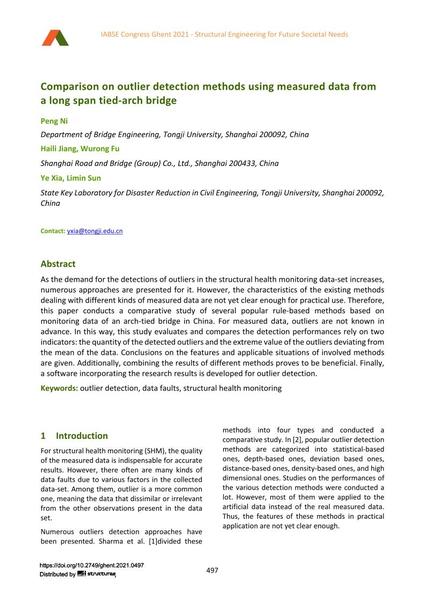Comparison on outlier detection methods using measured data from a long span tied-arch bridge

|
|
|||||||||||
Bibliographic Details
| Author(s): |
Peng Ni
(Department of Bridge Engineering, Tongji University, Shanghai 200092, China)
Haili Jiang (Shanghai Road and Bridge (Group) Co., Ltd., Shanghai 200433, China) Wurong Fu (Shanghai Road and Bridge (Group) Co., Ltd., Shanghai 200433, China) Ye Xia (State Key Laboratory for Disaster Reduction in Civil Engineering, Tongji University, Shanghai 200092, China) Limin Sun |
||||
|---|---|---|---|---|---|
| Medium: | conference paper | ||||
| Language(s): | English | ||||
| Conference: | IABSE Congress: Structural Engineering for Future Societal Needs, Ghent, Belgium, 22-24 September 2021 | ||||
| Published in: | IABSE Congress Ghent 2021 | ||||
|
|||||
| Page(s): | 497-503 | ||||
| Total no. of pages: | 7 | ||||
| DOI: | 10.2749/ghent.2021.0497 | ||||
| Abstract: |
As the demand for the detections of outliers in the structural health monitoring data-set increases, numerous approaches are presented for it. However, the characteristics of the existing methods dealing with different kinds of measured data are not yet clear enough for practical use. Therefore, this paper conducts a comparative study of several popular rule-based methods based on monitoring data of an arch-tied bridge in China. For measured data, outliers are not known in advance. In this way, this study evaluates and compares the detection performances rely on two indicators: the quantity of the detected outliers and the extreme value of the outliers deviating from the mean of the data. Conclusions on the features and applicable situations of involved methods are given. Additionally, combining the results of different methods proves to be beneficial. Finally, a software incorporating the research results is developed for outlier detection. |
||||
| Keywords: |
structural health monitoring outlier detection data faults
|
||||
| Copyright: | © 2021 International Association for Bridge and Structural Engineering (IABSE) | ||||
| License: | This creative work is copyrighted material and may not be used without explicit approval by the author and/or copyright owner. |
||||
